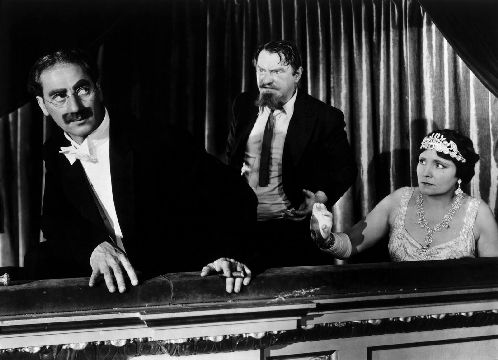A Night at the Opera (1935) 
“Don’t miss it! The funniest picture ever made!”

Director: Sam Wood
Cast: Groucho Marx, Chico Marx, Harpo Marx
Synopsis: A sly business manager and two wacky friends of two opera singers help them achieve success while humiliating their stuffy and snobbish enemies.
1935, and MGM knew just what a cash cow they had on their hands with the subversive Marx Brothers, if they could just polish off the raw edges and find a way to make the boys appeal to a universal adult audience rather than solely to the male members. The only way to do that was to tone down that subversive nature, and soften the target of their manic wit. The boys’ anarchic nature was diluted, and the figures of authority around whom they ran ragged circles were no longer government officials but stuffy grandees of the opera. The humour, however, still retained enough of their exuberance and mischievousness to disguise the transition from anarchic outsiders to misbehaving, but essentially harmless, rascals.
Groucho is Otis P. Driftwood, a chancer who has somehow found his way into the employ of the multi-millionaire patron of the arts, Mrs Claypool (the redoubtable Margaret Dumont). When Opera impresario Herman Gottlieb (Sig Ruman), persuades Claypool to sign up Italian tenor Rodolfo Lassparri (Walter Woolf King) to his New York Opera company, Driftwood attempts to muscle in on the deal by signing Lassparri up first. However, Driftwood mistakenly signs Riccardo Barroni (Alan Jones), a member of chorus, instead, thanks largely to the confusing negotiations of Barroni’s self-proclaimed manager Fiorello (Chico Marx).
They all set sail for New York, with Fiorello, Tomasso (Harpo Marx), Lassparri’s abused former assistant, and Barroni stowing away in Driftwood’s over-sized trunk. Barroni is in pursuit of Rosa (Kitty Carlisle), who Lassparri has chosen for his leading lady, and on whom he is also sweet. There follows a number of scenes which do little to move forward what scant plot the film possesses, but which show the Marx Brothers at the top of their game. The most memorable is probably the stateroom scene, in which a total of 15 people somehow manage to cram themselves into Driftwood’s tiny cabin. It’s rightly famous, and must have been even funnier when performed live on stage.
A Night at the Opera contains many of the Marx Brothers’ finest moments, but lacks the anarchic edge which had first made them famous, partly because of MGM producer Irving Thalberg’s decision to make them more mainstream, but also because of the confining restraints of the Hays Code. The humour is repeatedly interrupted by musical numbers — no doubt designed to woo female moviegoers — which, although well-staged, provide an incongruous mix with the Brothers’ humour. Ironically, A Night at the Opera, while undeniably one of the Marx Brothers’ finest cinematic outings, also marked the beginning of a slow decline in their screen fortunes.
(Reviewed 11th July 2012)
httpv://www.youtube.com/watch?v=tu6COUl3fx8
